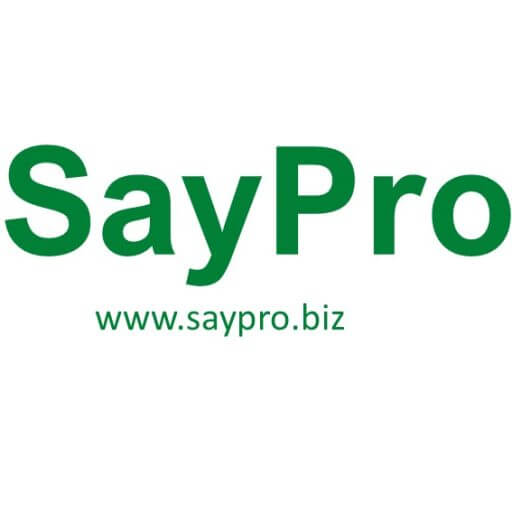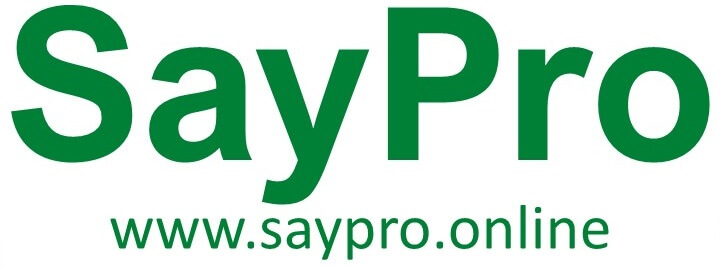Your basket is currently empty!

SayPro :Marketing Social Media Links Training Course
R4 999,00
Description
SayPro :Marketing Social Media Links Training Course
Module 1: Introduction to Social Media Marketing
Module 2: Setting Up Your Social Media Accounts
Module 3: LinkedIn: Building Professional Connections
Module 4: Facebook: Creating Pages and Groups
Module 5: Instagram: Visual Storytelling
Module 1: Introduction to Social Media Marketing
Objective
Introduce students to the world of social media marketing and emphasize the importance of connecting social media profiles and pages for a unified marketing strategy.
Content
- What is Social Media Marketing?
- Definition and evolution of social media marketing
- Benefits of using social media for business
- Key platforms for social media marketing
- Importance of Connecting Social Media Profiles
- Unified brand image
- Increased engagement and reach
- Streamlining marketing efforts across multiple platforms
- Overview of the SayPro Marketing Training Course
- What you’ll learn in the course
- Tools and resources to be used
- Expected outcomes after completion
Tasks:
- Task 1:Research and list 3 businesses that successfully use social media marketing. Identify their main social media profiles.
- Task 2:Reflect on your business or a business idea and describe how you could use social media for marketing purposes.
Assignment:
- Write a short (300-400 words) assignment on why connecting social media profiles is crucial for businesses in today’s marketing landscape.
Quiz:
- What is one of the main benefits of social media marketing?
- A) Increased television ad spending
- B) Ability to engage with a wider audience
- C) Limited exposure to potential customers
- Which of these platforms is most effective for B2B marketing?
- A) TikTok
- B) Instagram
- C) LinkedIn
- How does connecting multiple social media profiles help businesses?
- A) It limits customer engagement to one platform.
- B) It enhances brand recognition and streamlines communication.
- C) It decreases engagement on individual platforms.
Module 2: Setting Up Your Social Media Accounts
Objective
Teach students how to set up social media accounts on major platforms and ensure they are optimized for marketing.
Content
- Creating Business Profiles on Key Platforms
- Step-by-step setup for Facebook, Instagram, LinkedIn, Twitter, YouTube, etc.
- Tips for choosing the right account type (personal vs. business)
- Optimizing Profile Information for Branding
- How to fill out bio sections
- Importance of profile images, headers, and descriptions
- Creating a consistent brand voice across platforms
- Connecting Your Website with Social Media Pages
- Adding website links to social media profiles
- Integrating social media feeds into websites and blogs
Tasks:
- Task 1:Set up a new social media profile on either Facebook, Instagram, or LinkedIn for your business.
- Task 2:Review a well-known company’s social media profile and identify how they have optimized their page for branding.
Assignment:
- Create a complete social media profile for a new product or business. Ensure all branding elements (profile image, bio, header) align with the product’s identity. Submit a screenshot or document with the link to your profile.
Quiz:
- What information should be included in your social media profile bio?
- A) Personal hobbies and interests
- B) Brand values, services, and links to your website
- C) A lengthy explanation of your business history
- Why is it important to optimize your social media profile for branding?
- A) To attract more followers and build a professional image
- B) To confuse potential customers with unclear information
- C) To avoid engagement with your audience
- How can you connect your website to your social media profiles?
- A) By adding a website link in the bio or description section
- B) By avoiding any external links on your social media pages
- C) By sharing your website on personal accounts only
Module 3: LinkedIn: Building Professional Connections
Objective
Guide students through creating and optimizing a LinkedIn profile to build professional connections and promote their business.
Content
- Setting Up Your LinkedIn Profile
- Creating a company page vs. personal profile
- Importance of a professional profile picture and headline
- Optimizing the “About” section to attract business connections
- Linking LinkedIn to Your Website & Other Social Platforms
- Adding your website URL to your LinkedIn profile
- Cross-linking to other social media accounts (Instagram, Twitter, etc.)
- Best Practices for Networking and Engagement
- How to grow your network on LinkedIn
- Engaging with connections through posts, comments, and messages
Tasks:
- Task 1:Set up a LinkedIn business profile and connect it with your personal LinkedIn account.
- Task 2:Follow three industry leaders on LinkedIn and engage with their recent posts by commenting or sharing.
Assignment:
- Create a LinkedIn post about a new product or service you are offering. Include a professional image or video, and ensure the post is well-optimized for engagement.
Quiz:
- What is a key element of your LinkedIn profile that should be optimized?
- A) The “About” section and professional headline
- B) Only the profile picture
- C) Your followers’ list
- Why is it important to connect your LinkedIn account with other social media profiles?
- A) To share personal details
- B) To increase the reach and visibility of your posts across platforms
- C) To confuse your followers
- What is a good practice for growing your LinkedIn network?
- A) Only connect with family and friends
- B) Engage with relevant posts and join groups
- C) Ignore connection requests from professionals
Module 4: Facebook: Creating Pages and Groups
Objective
Learn how to create and manage Facebook business pages and groups for greater engagement and brand building.
Content
- Setting Up a Facebook Business Page
- Step-by-step guide to creating a Facebook business page
- Customizing your page (cover photo, about section, etc.)
- Linking products or services to the page
- Connecting a Facebook Page with Your Website
- Adding your website URL to the Facebook business page
- Using Facebook Pixel to track website visitors
- Utilizing Facebook Groups for Community Building
- Creating and managing a Facebook group for your brand
- Engaging with group members and fostering a sense of community
Tasks:
- Task 1:Create a Facebook Business Page for your business.
- Task 2:Join two Facebook groups relevant to your industry and observe the engagement practices within those groups.
Assignment:
- Set up a Facebook group for your brand or product and invite 5 potential members to join. Post at least one introductory post to engage the group.
Quiz:
- What should you include in the “About” section of a Facebook business page?
- A) Personal anecdotes and family stories
- B) Clear, concise information about your business and services
- C) Unrelated information about your hobbies
- What is the advantage of creating a Facebook group?
- A) Limited audience reach
- B) Building a community around your brand for deeper engagement
- C) No engagement opportunities for members
- How can you connect your website to a Facebook business page?
- A) By adding your website link in the bio or “About” section
- B) By only sharing blog posts on your page
- C) By not adding any external links to your page
Module 5: Instagram: Visual Storytelling
Objective
Guide students in setting up an Instagram business profile and using it to tell a visual story that engages their audience.
Content
- Creating an Instagram Business Profile
- Steps to set up a business profile on Instagram
- Switching from a personal to a business account
- Customizing your profile for branding
- Linking Instagram to Facebook and Your Website
- Connecting Instagram to Facebook for easier cross-posting
- Adding website links in bio and posts
- Strategies for Growing Followers and Engagement
- Posting quality content that aligns with your brand’s story
- Engaging with followers through Stories, polls, and comments
Tasks:
- Task 1:Set up your Instagram business profile and ensure all information is optimized for your brand.
- Task 2:Research and follow 5 influencers in your industry, then engage with one of their posts by commenting or sharing.
Assignment:
- Post a story or carousel on Instagram showcasing your brand’s product or service. Include a call-to-action (CTA) encouraging followers to visit your website.
Quiz:
- What type of account should you use for your business on Instagram?
- A) Personal account
- B) Business account
- C) Creator account
- Why should you connect your Instagram account to Facebook?
- A) For easy sharing of posts across both platforms
- B) To limit engagement to Instagram only
- C) To avoid posting on both platforms
- What is an effective way to increase engagement on Instagram?
- A) Post only once a month
- B) Engage with followers through stories, polls, and comments
- C) Ignore comments and direct messages
You must be logged in to post a review.
Vendor Information
- No ratings found yet!
-
SayPro :Marketing Disaster Recovery Training Course
R5 999,00 Add to basket -
SayPro :Marketing Help Desk Training Course
R6 999,00 Add to basket -
SayPro: Marketing Email Marketing Training Course
R5 999,00 Add to basket -
SayPro: Marketing Banner Ads Training Course
R4 999,00 Add to basket -
SayPro :Marketing Security Training Course
R5 999,00 Add to basket -
SayPro: Marketing Data Backup Training Course
R3 999,00 Add to basket














Reviews
There are no reviews yet.